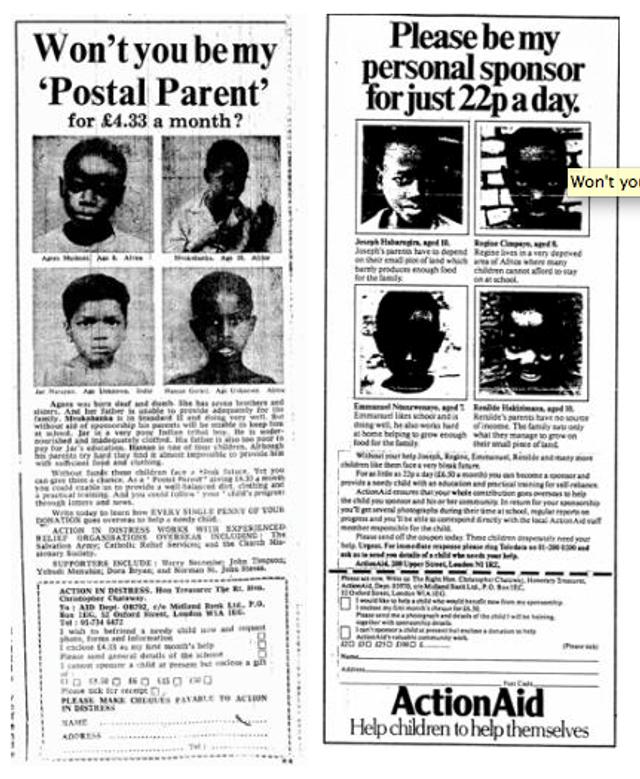ActionAid: the ‘postal parent’ advert
- Exhibited by
- SOFII
- Added
- October 28, 2009
- Medium of Communication
- Press advertising.
- Target Audience
- Individuals, regular gift.
- Type of Charity
- Children, youth and family.
- Country of Origin
- UK.
- Date of first appearance
- 1976.
SOFII’s view
The two black and white ads below looks very dated now, and the first of these at least seems particularly patronising too. But when these ‘postal parent’ advertisements appeared in the UK in the mid 1970s they were state-of-the art, the epitome of direct response fundraising. For press advertising off-the-page they were masterful examples of how to use a small space effectively, with not a millimetre of waste. The direct proposition, the inclusion of a price in the headline, the positioning of headline photographs and copy were all carefully constructed and tested, deliberately planned and structured. Harold Sumption, creator of these ads, described them as ‘… looking like they’d been put together by amateurs; two little old ladies working with passionate conviction in a leaky garret, rather than by a sophisticated West End advertising agency.’
But for fundraisers, the really interesting thing about the postal parent ads is why they were deliberately scrapped at the height of their effectiveness and replaced by something that only worked half as well.
Creator / originator
These ads were conceived and written by Harold Sumption, based on an approach he had developed when responsible for advertising at Oxfam. (Harold was also the founder of the International Fundraising Congress, held each year in Holland.) Harold also supervised press advertising and fundraising generally at Help the Aged, as well as ActionAid.
For more on Harold and his brilliance, see here, here and here.
Summary / objectives
To recruit new donors cost-effectively for ActionAid’s child sponsorship scheme.
Background
ActionAid can claim to be Britain’s first fully direct marketed charity. In the late 1970s it began to grow extremely quickly and for much of the late 70s and early to mid 1980s it was acknowledged as the fastest growing charity in Britain. The driving force behind much of that early growth was these hugely successful press advertisements.
Although it indulged in several other forms of fundraising, including charity gift shops and special events, ActionAid’s success and growth derived almost entirely from effective direct marketing. Most of this was in the form of off-the-page advertising and loose inserts, for donor acquisition, followed by effective donor development through regular direct mail.
ActionAid tested press recruitment rigorously and became highly adept at it. This and the appeal of child sponsorship led to ActionAid being described as the fastest growing British charity in the early 1980s. By around 1982 or 83 it had entered the UK’s top 20 by voluntary income.
Special characteristics
Child sponsorship is often described as the best fundraising proposition in the world. And, as a fundraising mechanism, this is probably true. But a child sponsorship scheme not properly regulated and sensitively presented can also be considered patronising, selective and potentially misleading. The ‘postal parents’ ads, in many ways, were blatantly symptomatic of this, being patronising in the extreme. So despite their success many marketing and programme staff, led by ActionAid’s CEO at the time, Roland Hodson, were uncomfortable with the messages and impressions given by these ads and wanted to see them changed.
Since starting in child sponsorship in the mid 1970s ActionAid (until 1980 it was known as Action in Distress) had been increasingly aware of and sensitive to criticism of the child sponsorship mechanism, particularly from the likes of New Internationalist magazine but also from Oxfam, Christian Aid and others. Though not all of this criticism was well-informed or well-founded, ActionAid management was well aware of some of the limitations of child sponsorship and shared those concerns, so worked to develop its own distinctive brand of justifiable child sponsorship, which sought to retain the benefits of the fundraising mechanism and adapt these to the practical reality of the fight against poverty. So at this time much was done to improve the way child sponsorship worked. In the late 1970s, when ActionAid was still very small and new, senior staff made the decision to ditch the massively successful ‘postal parents’ ads, knowing this would cut the number of sponsors that the charity could afford to recruit approximately in half. Thus at a crucial early stage in its development ActionAid voluntarily slowed its own growth so that it could do ‘the right thing’. The charity prospered and grew nevertheless.
Details
All ads were rigorously tested and each insertion was scrupulously recorded in detail in a guard book. ActionAid learned that 20 cm doubles were almost always more cost effective for ‘normal’ press usage (bigger ads might be justifiable when demands for quantity outweighed concerns of cost per enquiry), that head and shoulders pictures were more effective than full body pics , that four head and shoulders photos worked best of all, and so on.
Costs
ActionAid was almost invariably able to negotiate deals beyond normal charity discounts. If a cash reduction was not possible the media buyer almost always asked for special positions, which usually would not be paid for.
Results
Consistent improvement in cost-per-sponsor throughout the late 1970s and early eighties.
Merits
The ‘postal parent’ ads were spectacularly successful advertisements. The decision to scrap them and the thinking behind that decision are worth noting.
 View original image
View original image
 View original image
View original image
















